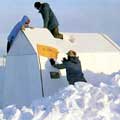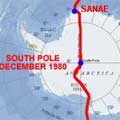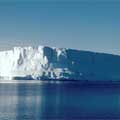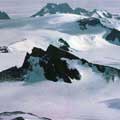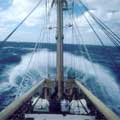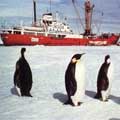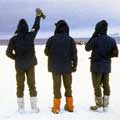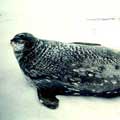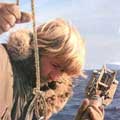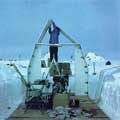Ship’s Stories: Capetown to the Antarctic
The Benjamin Bowring left Cape Town on 22nd December 1979 bound for a remote bay on the Antarctic continent at a point where the Greenwich Meridian crosses the frozen coast. The ship was laden with a cargo of 600 oil drums containing fuel for the Expedition aircraft, the skidoos, generators, cookers and heaters.
In addition, the ship was carrying about 20,000 cubic feet of dry stores, equipment and, most important the cardboard sections which, when joined together, make up the “Base Camp” huts. These would be erected during the remaining months of the Antarctic summer.
In order to make the best use of the limited summer period for crossing Antarctica, it was decided that this first summer should only be used to get to Antarctica by ship and for the base camps to be erected and all preparations made for a crossing the following summer. Thus a full season could be used to cross this vast continent.
As the ship headed south from Cape Town, it became apparant that Antarctica was not an easy place to reach. The weather became unpleasant on our second day out and the sea developed a considerable swell which was to stay with us as we crossed the Roaring Forties. Despite the discomfort, the Roaring Forties did not fully live up to their evil reputation and we only encountered gale force winds on two occasions.
During this passage, we were joined by a number of additional people which brought our numbers up to 29 in all. Apart from the 15 members of the ship’s crew, we had on board Ran Fiennes, Oliver Shepard, and Charlie Burton – who would actually cross Antarctica during the following summer, Virginia Fiennes, Simon Grimes, David Mason and Anthony Birkbeck – who were responsible for manning the base camps and providing the necessary back-up. In addition, we had with us a four man film crew, a photographer and two scientists from Cape Town University. The scientists were with us so that they could make a record of the sea temperatures/salinity and study the density and distribution of plankton along our route.
Plankton is a very basic life form – rich in protein and therefore important food for sustaining other marine life, including the baleen whales. As such it forms a key to the ecosystem of Antarctic marine life and is thus of considerable interest to scientists. As there is suspected to be so much plankton in Antarctic waters it has been suggested that we humans might harvest these tiny creatures for our own consumption.
The variety of different occupations pursued by individuals made this period at sea very interesting. Despite the increase in numbers on such a small ship, we all remained on excellent terms with each other and life on board was very pleasant.
Three days out from Cape Town we celebrated Christmas. At 10.30 p.m. on Christmas Eve we all met together in the main saloon and enjoyed a singsong. It was a lighthearted affair and the saloon was suitably decorated with streamers, baloons and a Christmas tree. We all took turns to sing songs most of which created a great deal of laughter. Outside the night air was cold and the long swell kept the ship rolling from side to side. The watchkeepers on the bridge and in the engine room attended to all the necessary chores that kept the ship under way and heading south. At midnight, Jill – the cook – produced hot mince pies and Irish coffee before the majority of us drifted off to bed. Christmas Day was enjoyed in a traditional manner despite our surroundings. There was a short church service followed by a superb lunch. As a first course we had avocado Salad followed by turkey and a host of vegetables and finally Christmas Pudding with rum butter (we had no brandy on board). Only watchkeepers and Jill, the cook, worked the rest had the day off although many helped to organise and prepare the food and festivities.
On the 28th December we sighted our first iceberg at a latitude of 51° South. Antarctic icebergs are most commonly tabular in shape. This means that they usually have cliffs all around their perimeter and a flat “table” top. They are formed by glaciers which spill from the highlands of Antarctica down to the coast and then protrude out into the sea. These massive tongues of ice float and form an extension of the coast. It is as a result of the break up of an ice tongue that icebergs are born. The thickness of the ice varies but some icebergs can be as much as 150 feet or more in height from sea level. Their mass under water is enormously greater than their visible mass and it is fair to assume that the submerged volume of an iceberg can be more than 80% of its overall mass. Because so much of the iceberg is below water, it responds to currents rather than wind and so these huge floating islands leave the Antarctic coast and travel wherever the ocean currents take them until they eventually breakup and melt. We saw many icebergs and several were between 1 and 2 miles in length. There have been many sightings of much larger icebergs (up to 50 miles or more in length) but even those that we saw were probably as heavy as 20-30 million tons.
Having sighted our first iceberg, we began to notice others and it was not long before we passed within a mile of a very impressive tabular ‘berg. The brightness of the pure white ice was dazzling. It was so clean and had a distinct blue glow radiating from certain places. All around were small boulders of ice which had fallen off the sides of the ‘berg. These are called “growlers” and can be particularly hazardous to ships as they are not easy to see in the water and are not noticeable on radar. However, we thankfully never hit one.
New Year’s Eve was celebrated with mulled wine and more singing. Ken Cameron, Chief Engineer, had thoughtfully remembered to bring haggis and salmon from his home in Scotland when he joined the ship. And so we were able to celebrate Hogmanay in true Highland style.
On New Year’s Day while a group of the ship’s company were promenading on deck after lunch, we sighted what we assumed to be pilot whales. Many varieties of sea birds were frequently observed. These included: Albatrosses, Prions, Skuas, Petrels and Cape Pigeon.
The amount of marine life seemed to be increasing and it was getting noticeably colder. The next day in the early hours of the morning, the ship entered very open pack ice. By evening, we were grinding our way through close pack.
Pack ice creates a formidable barrier around the Antarctic coast. Each year during the winter months the sea surrounding Antarctica freezes into a solid layer which can extend as much as 1,000 miles out from the coast. As summer approaches this ice breaks up into smaller floes which form a belt around the coast usually some miles offshore. The ice in this belt is often several years old. It glows with a fluorescent blue colour and can be more than 9 feet thick. Often, as a result of storms, these floes ride up on top of each other and thus several layers can accumulate in a stack forming hummocks of considerable height and as solid as granite.
Before leaving Cape Town, we had tried to get predictions of the precise location of this belt of ice but as we were departing before any other ships to that area it was easier for us to monitor the ice movements for ourselves by using our satellite picture recorder. Each day a satellite passes overhead taking pictures of the world below. We have a printer on board that can produce a black and white print of these photographs while the satellite is in transit overhead. It is therefore possible to foresee the weather patterns, cloud formations and ice distribution over a large area of the southern ocean.
The Benjamin Bowring was specially designed to be able to navigate through pack ice. The ship’s hull was strengthened and shaped so that on encountering floes the bows wouId ride up onto the ice and by resting on it crack the floe, thus opening a lead through which the ship might pass. A conventional vessel would not be strong enough to do this and would be most likely to damage her hull on the very hard ice.
In open pack there is plenty of room for the ship to manoeuvre and many of the floes are easily pushed aside but as the ice closes up, there is less open water thus the room to manoeuvre is reduced and there is a greater chance of getting beset.
We spent only three days in the pack ice and managed to maintain an average speed of 3 knots. We were never stopped by the ice and only once did we have to turn around and retrace our route to find more open water. Throughout the period in the pack ice we kept a lookout watch from our crows-nest and it was the lookout who usually suggested a route that would take us safely through the floes. In some places the ice was very thick and it was surprising how well the Benjamin Bowring managed to force a way through a seemingly solid area of thick, hard and flat ice. The impact of hitting the ice sent shudders through the hull followed by the lifting of the bows. Looking down from the forecastle, it was a fascinating sight as a sudden crack would appear and widen and slowly the bows would lower and the ship move on with the ice scraping along the side of the hull.
Finally we entered more open water. The large solid ice floes disappeared behind us and we found ourselves approaching the towering white cliffs of the Antarctic continent. It was an impressive sight with sheer cliffs of ice stretching across the horizon. The sky was a bright clear blue and the air was fresh but relatively warm.
We altered course and followed the coast for about 20 miles to the west where we encountered a series of bays. Our destination was called Polarbjorn Buchte (Polarbear Bay). We arrived at midday and turned the ship to lie alongside the low flat sea ice that covered the bay. This sea ice appeared to be a good sound platform for us to unload our cargo onto. On either side of this frozen platform, the cliffs formed the perimeter of the bay and met at an apex where a ramp from the sea ice led to the higher ice on the cliffs. This ramp would provide us with the access to our proposed depot of stores which we would have to start work on quickly.
This bay is also used by the South African ship S.A. Agulhas which supplies the South African base ‘Sanae’. This base was manned by 19 men, most of whom were scientists involved in research work. They had been in the Sanae base (some 18 kilometres from the bay) throughout the entire austral winter since the previous summer. We had established radio contact with these South Africans several days prior to our arrival and it was arranged that they would meet us in Polarbjorn Buchte and advise us on the best place to berth the ship.
Even though we had had contact with these men it was extraordinary for, us but more so for them to meet other people in this desolate place. We were the first ‘outsiders’ that they had met since the Agulhas left 14 months ago.
It wasn’t long before we had the ship secured alongside with stout poles driven into the ice. A small group of Adelie penguins followed us around as we made the ropes fast to the poles. They were fascinated by our presence and appeared to be little concerned by our activities. From a short distance inland, three large Emperor penguins and three Weddell seals observed us as they basked in the sun. They seemed totally disinterested in us and made no attempt to indicate if our presence was welcome or not.
Ran and the leader of the South African team climbed onto a skidoo and set off inland to see the lie of the land. Our next major problem was to unload the ship and with our own vehicles move the stores, equipment and fuel to a safe depot away from the relatively fragile sea ice of the bay. Ran had organised a carefully thought-out procedure for unloading the cargo. The plan involved everyone on board and in view of the permanent sunshine the plan also meant long hours of hard work for us all. The most important aim was to get an airstrip established for our Twin Otter aircraft so that it could safely land. After that we had to start ferrying the stores in order of importance so that the Otter could fly them up to Borga where the main overwintering base would be built.
Borga Massif is a mountain range which is almost completely covered by an accumulation of ice layers so that only the peaks are visible above the surrounding flat ice. Peaks like at Borga are called ‘nunatacks’ and our base camp was to be established at the foot of the bare rock cliffs that form the summit of one of these 10,000 feet mountains. The cliffs themselves are 2,000 feet high and the altitude of our base was to be 7,500 feet above sea level and at a distance of some 180 miles inshore from our Sanae depot.
Before unloading started, Ran and Charlie Burton made a reconnaissance of the area around Sanae. First they found the most suitable site for a landing strip and marked it with flags on long poles. Then they marked the depot lines where all the cargo should be placed. A suitable site for the Sanae Hut, where Simon Grimes and Anthony Birkbeck would be spending the forthcoming winter, was found and finally a safe route from the ship to the depot lines was marked out carefully avoiding crevasses and the cracks in the bay ice.
After a briefing we all set about our respective chores. Some had to be on board to unload the ship, others had to be on the sea ice to release the loads as they were landed. Four skidoos (motorised sledge) and a small snowcat with sledges in tow made the journey to the depot lines from the ship. At the depot lines the stores were placed in tidy rows on the ice. A master plan detailing the location of every box was carefully maintained so that in the event of a blizzard there would be no problem in retrieving the boxes despite the fact that they might be covered in a layer of snow and blown ice particles. The Sanae hut was assembled in readiness for the ship’s departure and slowly but surely the stores made their way up the ramp onto the higher and safer ice 2 miles inland from the ship.
This work continued day and night for several days. Everyone worked long hours – skidoo drivers for instance worked 12 hours non-stop then had 4 hours off before starting another 12-hour shift. Temperatures were never above freezing and in the early hours of the morning when the sun was at its lowest, the air was very cold. When the wind blew the cold increased and it was not uncommon for the temperature to be around -20°C. Skidoo drivers had to keep especially well wrapped up in warm clothing as they had to drive their machines into the wind thus increasing the chill factor. Goggles were vital to prevent snow blindness from the sun’s reflection in the ice. Each skidoo had to carry survival rations, signal flares, a compass and a sleeping bag as well as a can of spare fuel. This was in case a blizzard should develop when visibility suddenly deteriorates and it is very easy to get lost. In such an event it would be important to remain stationary until help arrived and to remain out in a blizzard can be very dangerous without proper survival equipment. We were all linked with portable radio telephones so that we could communicate with each other at all times. On the ship’s bridge, the watchkeeper observed the weather and kept a constant check on the wind speed and direction, visibility, and particularly the barometer. Any noticeable change was reported to all those ashore as a warning.
Only once did the weather halt operations. A gale force wind rapidly stopped our work and everyone took shelter either on the ship or in a hut at the depot lines. During the gale the ship’s moorings parted and it became necessary to leave the coast and ride out the storm at sea. The sea ice in the Buchte started to break up and during our vigil at sea we observed a small floe passing us by with ten solitary oil drums disappearing into the blinding snow and ice that was blowing off the coast. Luckily these drums were the only cargo left on the ice edge as it would have been disastrous to lose any of the more vital equipment or stores.
During the last stages of the gale, the Benjamin Bowring returned to the Buchte and with the engine driving the ship ahead we wedged the bows into the ice and waited patiently for the wind to abate. After 36 hours, the ship was safely resecured alongside the ice and the unloading continued.
During the gale, the aircraft (which had flown down to Antarctica from England via Canada and North and South America) was grounded at Halley Bay (a British research station) only 600 miles to the south west of Sanae. When the weather cleared, we received news that the aircraft with pilot, Giles Kershaw and flight engineer, Gerry Nicholson were on their way. During the afternoon of 10th January our work was suddenly interrupted by a roar of engines and the very exciting sight of the Twin Otter skimming over the surface of the bay towards the ship. Having surveyed the area from the air Giles finally landed on the airstrip and for the first time during the Expedition all the members were together in one place.
Since the Aircraft was now with us, the work schedule changed. Apart from a few oil drums, we had successfully unloaded the ship ahead of schedule. It only remained to attend to the unloading of a further 600 fuel drums from the South African Ship Agulhas which arrived in the Buchte on 11th January.
The Agulhas was at Sanae to supply the South African base and to transport the relief crew in to replace those who had already spent over a year in Antarctica. She was a much bigger ship than ours and was only built 2 years ago. Her complement of crew, scientists, helicopter pilots and mechanics and innumerable others amounted to 90 people. Suddenly our own little world was inundated with people and heavy snowcats. Our 600 drums were unloaded with great speed and the South Africans towed them up to our depot lines. We unloaded the drums from the sledges with their help and this done we had completed the job of setting up the depot.
The new schedule involved loading the aircraft with essential stores and hut sections for the Borga base. Ran and Virginia flew up to Borga and erected a tent. They marked out a depot at Borga similar to the one at Sanae. An airstrip was cleared and marked out and the stores began to arrive. For the next few days we continued our new rota – refuelling the aircraft, loading it and preparing more loads, taking into account the weight of each item thus preventing the chance of overloading the plane. Simon Grimes, Anthony Birkbeck and David Mason replaced Ran and Virginia at Borga. These three started to erect the huts and unload the stores that arrived every 3 hours by aircraft.
The ship could have stayed longer at Sanae. There was still plenty of work to do but sadly we had our own schedule to attend to and we were anxious not to get caught in the pack ice. Although the weather was fine there was a strong chance that there could be a swift deterioration which could make a later departure awkward. So on the 17th January we bade farewell to the ‘overlanders”. The parting of our ways would not have been complete without a proper party and on the previous evening all of us gathered together in the saloon on board Benjamin Bowring for a final meal. This was followed by speeches and a sing song. Everyone was in good spirits.
We made our departure quietly. The ‘overlanders” stood on the ice edge and we waved to that little group until the ship passed around a headland that obscured them from view. On board there was a quietness. Only the 15 ship’s crew and the 2 scientists remained on board out of the 29 who started on the voyage south from Cape Town. We had a long voyage ahead of us back through the pack ice and the turbulent Southern Ocean.

